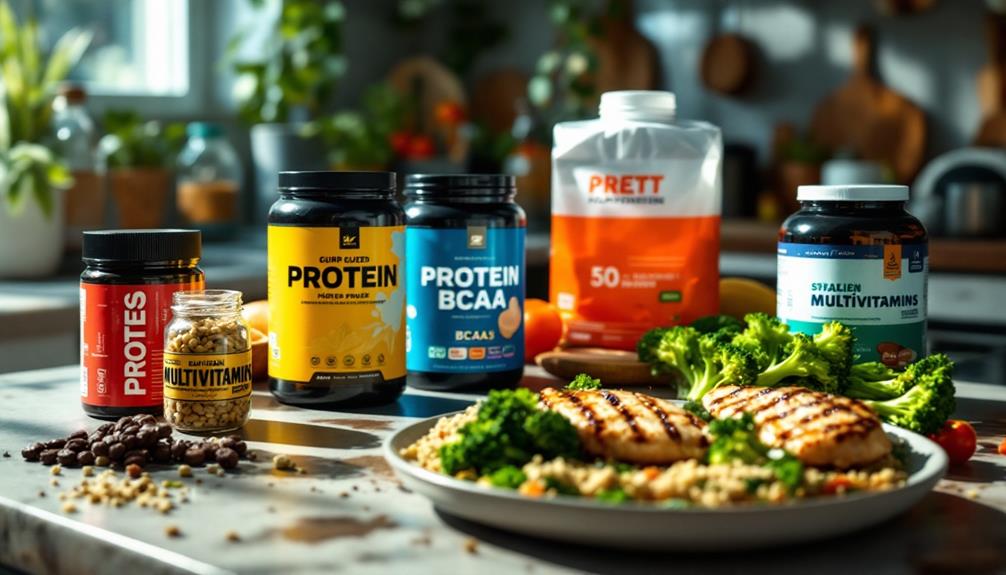To maintain strength while cutting, start with these five tips. First, prioritize protein intake, aiming for 1.2 to 2.2 grams per kg of body weight daily. Next, optimize your workout routine with compound movements and lower rep ranges, focusing on intensity. Manage your caloric deficit wisely by tracking macronutrients and keeping it around 500 calories. Stay hydrated by drinking water regularly and bear in mind you're getting 7-9 hours of sleep. Consider strategic supplementation, like protein powders and creatine, to support muscle preservation. Stick with these strategies, and you'll find stronger results ahead. There's more to explore on this journey!
Core Insight
- Prioritize protein intake by consuming 1.2 to 2.2 grams of protein per kg of body weight daily to preserve muscle mass.
- Focus on compound movements in your workouts, such as squats and deadlifts, to maintain strength effectively.
- Implement progressive overload by gradually increasing weights or resistance in your training routine.
- Create a caloric deficit of about 500 calories daily while ensuring nutrient-rich foods are consumed to support energy and recovery.
- Stay hydrated and aim for 7-9 hours of quality sleep to enhance recovery and overall performance during cutting.
Prioritize Protein Intake

To maintain strength while cutting, it's important to focus on protein intake. Protein helps preserve muscle, especially when you're eating fewer calories. Aim for about 1.2 to 2.2 grams of protein for every kilogram of your body weight each day. This will help protect your muscles as you lose fat.
When selecting supplements during your cutting phase, consider caffeine-free pre-workouts. They can help you stay energized during workouts without affecting your sleep.
Include high-quality protein sources in your meals, such as lean meats, fish, eggs, and plant-based options like lentils and quinoa. Don't overlook protein-rich snacks, as they can help you reach your daily goals without making you feel too full.
It's also helpful to spread your protein intake evenly throughout your meals. This approach supports muscle growth. By focusing on protein, you can effectively maintain your strength during your cutting phase.
Optimize Your Workout Routine

To maintain strength while cutting, it's important to optimize your workout routine. Focus on compound movements like squats, deadlifts, and bench presses. These exercises work multiple muscle groups, which helps you lift heavier and keep your strength. Aim for a lower rep range of 4 to 6 reps to help preserve your muscle power. Using BCAAs for recovery can be helpful during a cutting phase, as they reduce muscle soreness and fatigue, allowing you to maintain workout intensity even when you're in a caloric deficit.
Consider progressive overload by gradually increasing weights or reps each week. Keep your workouts intense but efficient, aiming for 45 to 75 minutes per session. Don't forget to schedule rest days for muscle recovery. Lastly, align your workouts with your goals, adjusting the volume and intensity as needed. This approach will help you stay strong while losing fat.
Manage Caloric Deficit Wisely

Managing a caloric deficit wisely requires a clear plan to ensure your body gets the fuel it needs. Start by figuring out how many calories you need each day. A safe and effective way to lose weight is to create a deficit of about 500 calories daily. This approach can help you shed pounds without losing muscle. If you're on a ketogenic diet, using keto supplements can help keep your energy up and support fat burning while you're in a caloric deficit.
Focus on eating nutrient-rich foods, like lean proteins, whole grains, fruits, and vegetables. These foods are packed with vitamins and minerals and will help you feel full longer.
It's also important to keep track of your macronutrients, especially protein, to ensure you're maintaining muscle. Aim for about 1.2 to 2.2 grams of protein for each kilogram of your body weight. This will help you stay strong while you lose weight.
Stay Hydrated and Rested

Staying hydrated and well-rested is crucial for keeping your strength while cutting. When you don't drink enough water, it can hurt your performance and recovery. Try to drink at least half your body weight in ounces of water each day. Sleep is just as important. Getting good rest helps your muscles recover and grow, which supports your strength goals.
| Hydration Tips | Rest Tips |
|---|---|
| Drink water regularly | Aim for 7-9 hours of sleep |
| Carry a water bottle | Create a bedtime routine |
| Listen to your body | Limit screen time before bed |
Incorporate Supplementation Strategically

Using supplements wisely can really help you keep your strength during a cutting phase. Start by adding protein supplements to your routine. They are great for preserving muscle mass when you're eating fewer calories. Look for high-quality options like whey or plant-based proteins to hit your daily protein goals. Choose products that have a complete amino acid profile, especially those rich in BCAAs and leucine, which are crucial for maintaining and building muscle. If you find it hard to get enough calories from whole foods, consider lean mass gainers to help meet your needs.
Next up is creatine. This supplement is known to boost strength and performance, even when you're cutting. Just taking a daily dose can help keep your energy levels up during workouts.
Don't overlook branched-chain amino acids (BCAAs). They can help reduce muscle soreness and support recovery, making it easier for you to train hard and bounce back quickly.
Frequently Asked Questions
How Do I Track My Protein Intake Effectively?
To track your protein intake effectively, use a food diary or app. Measure portions accurately, read nutrition labels, and set daily goals. Regularly review your intake to guarantee you're meeting your protein needs consistently.
What Are the Signs of Muscle Loss While Cutting?
When your body feels like a deflating balloon, it might signal muscle loss. Look for signs like decreased strength, fatigue during workouts, and a drop in muscle size. Listen closely; your body's trying to tell you something.
Can I Still Build Muscle During a Caloric Deficit?
Yes, you can build muscle during a caloric deficit, but it's challenging. Focus on high protein intake, strength training, and ensuring you're not in too deep a deficit. Your body still needs proper nutrients to grow.
How Often Should I Change My Workout Routine?
You shouldn't put all your eggs in one basket. Change your workout routine every four to six weeks to keep your body guessing, prevent plateaus, and maintain motivation. Variety's the spice of life, after all!
Are There Specific Foods That Help Preserve Strength While Cutting?
Yes, certain foods can help you preserve strength while cutting. Focus on high-protein options like lean meats, legumes, and dairy. Incorporating healthy fats and complex carbs also supports energy levels and muscle maintenance during your cut.

